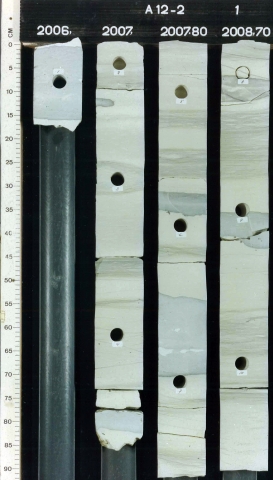Status
Formal (Van Adrichem Boogaert & Kouwe 1994).
Lithological description
White, chalky limestones containing rare white and grey nodular and bedded chert layers and thin, grey to green clay laminae. Some glauconite can occur in the basal interval. The unit displays a characteristic gradual increase in acoustic- and resistivity-log readings.
Depositional setting
Relatively stable, low-energy conditions in carbonate-shelf and upper bathyal environments. The rocks consist essentially of pelagic, biogenic remains, which settled from suspension. A variety of subfacies has been recognised, reflecting variation in sedimentation rate and water depth. In many localities Campanian-Maastrichtian fossil associations indicate considerably shallower water conditions than Turonian-Santonian associations (e.g, lower plankton/benthos ratio). Particularly in the northern A and B blocks, where the formation may have been deposited in deeper water, redeposition by gravitational mass flow occurred. This is reflected in thin sections by a typical brecciated microstructure of the rocks. The Ekofisk Formation represents post-inversion deposits which onlap onto and overstep inverted basins.
Definition of lower boundary
Characterised by a change to a slightly higher response and somewhat more serrate pattern of the gamma-ray curve, and a lower porosity in the basal Ekofisk Formation, as can be observed on the appropriate wire-line logs when compared to the underlying Ommelanden Formation. In general, most of the formation shows a somewhat higher porosity than the uppermost Ommelanden Formation. Very rarely a high peak is seen on the gamma-ray log, representing a Cretaceous/Paleogene boundary clay layer. Locally, a densely cemented hardground level, overlain by a glauconite-rich bed, may occur around this boundary.
Definition of upper boundary
The boundary with the overlying sands and clays of the Lower North Sea Group is expressed clearly on wire-line logs by the characteristic pattern: a low gamma-ray response and a high acoustic velocity.
Geographical distribution
Occurs locally in the northern and southern Netherlands North Sea sector. The Ekofisk Formation is the offshore equivalent of the Houthem Formation. The name Ekofisk Formation is applied only to offshore occurrences.
Regional correlation
UK: Ekofisk Formation; GER: not present; BEL: Mons Formation (erosional remnants) and Houthem Formation.
Hypostratotype
Comments:
In the northern Netherlands offshore area an interval of Paleocene chalk is often found. In accordance with the lithostratigraphy in the adjoining offshore sectors of Denmark, Norway and the United Kingdom this interval has been split off from the Ommelanden Formation and placed in the Ekofisk Formation, which was defined by Deegan and Scull (1977), with the type section in the Norwegian well 02/04-05.
Origin of name
The name is commonly used for lithological equivalents in the Danish and Norwegian sectors, and part of the UK sector of the North Sea. Named after the Ekofisk Field in the Norwegian offshore block 2/4, which produces from the Chalk Group.
Previous name(s)
Before 1994 (Van Adrichem Boogaert & Kouwe 1994) these deposits were included in the Ommelanden Formation.
Reviewed by (date)
Mark Geluk, Geert-Jan Vis (June 2017).
References
Deegan, C.E. & Scull, B.J. (comps.) 1977. A standard lithostratigraphic nomenclature for the Central and Northern North Sea. Institute of Geological Sciences, report No. 77/25, bulletin 1, 36 p.
Van Adrichem Boogaert, H.A. & Kouwe, W.F.P. 1994. Stratigraphic nomenclature of The Netherlands; revision and update by RGD and NOGEPA, Section H, Upper Cretaceous. Mededelingen Rijks Geologische Dienst, 50, 1-20.
Cite as
TNO-GDN ([YEAR]). Ekofisk Formation. In: Stratigraphic Nomenclature of the Netherlands, TNO – Geological Survey of the Netherlands. Accessed on [DATE] from https://www.dinoloket.nl/en/stratigraphic-nomenclature/ekofisk-formation.
